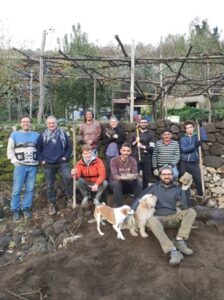Dry Stone wall construction is an ancient practice that requires great care and patience. However, the result is an extremely strong and durable structure which is able to withstand severe weather and natural forces. Dry stone walls are also aesthetically pleasing and they blend perfectly with their surroundings, creating a synergy between nature and humanity.
All about the stones
Local material and stones are used. A common stone in Campania and specifically in Tramonti is Tuff stone. With volcanic activity, new material was brought to the surface. Tuff stone can even appear in different colours all around Campania. The Neapolitan yellow tuff, also called “Pozzolana”, was formed more than 10.000 years ago. You can even find some fossils in the stone, since the ash was erupted into the sea. Due to its porous nature, Tuff is able to absorb water and to withstand the elements. Moreover, tuff is a relatively easy material to mould and carve, which makes it ideal for dry stone wall construction.
If you continue to drive past the Amalfi coast towards Naples, you will go through the coast of Sorrento. Between Sorrento and Meta thick coats of grey-brownish tuff banks rank at the cliffs. North of Tramonti, behind the Monte Lattari, greyish tuff was formed way over 30.000 years ago.
Why choose traditional construction?
Dry stone wall construction requires a lot of time, attention and precision if you don’t use “more modern” ways like concrete. The main advantage for the traditional repair is the permeability of water. Unfortunately, concrete still gets sometimes used, the low costs, an “instant” repair and no need of the special rebuilding technique is required. Although, the negative effects of the “more modern” walls can be seen. Their plain surface gives no habitat for flora and fauna. Although Dry stone construction requires more work than modern ways, it’s an ancient art that is worth preserving.
To construct the actual wall, you can think that this follows the same principle as Tetris. It’s important not to leave big gaps between the stones, so no soil is washed out when it rains. In some cases, the stones have to be modified by getting them into the right shape with a hammer.
The work
Repairing the wall in the garden of ACARBIO took around two days. A local craftsman was handling the construction. It started the removal of soil to have enough space for the stones to fit in. Then, a ditch was dug where the first layer of stones were placed, this will help for stabilisation. Carefully, one stone was put after another. The wall was built from the bottom up, layer by layer. At first, hard white rocks from the mountains were used. After one layer of stones soil was placed behind the rocks. Next to the wall there was a little mountain of soil that was transported by hand shovelling before. But little by little it began to shirk.

The replaced wall was around 2 metres wide and 1,8 metres high, the higher the wall was rebuilt, the harder the work was. The mountain of soil was getting smaller and so it was harder to shovel the soil and since the wall was getting higher, the buckets had to be lifted higher as well (but thankfully we had enough motivated interns and volunteers who were eager to help).
Now, we have to wait how long the wall will stand, but it should do fine for the next few years!

The PATHWAY OF TERRACES
This element is on the pathway of terraces which was created in the ESC Solidarity project Incontriamoci nei terrazzamenti. Find out more: www.acarbio.org/en/icontriamoci-nei-terrazzamenti or https://www.google.com/maps/d/u/0/edit?mid=1d41bjKkL4b_PqDAnVSB4NGr7PKnHWpo&ll=40.70315258759983%2C14.634084051706061&z=20
